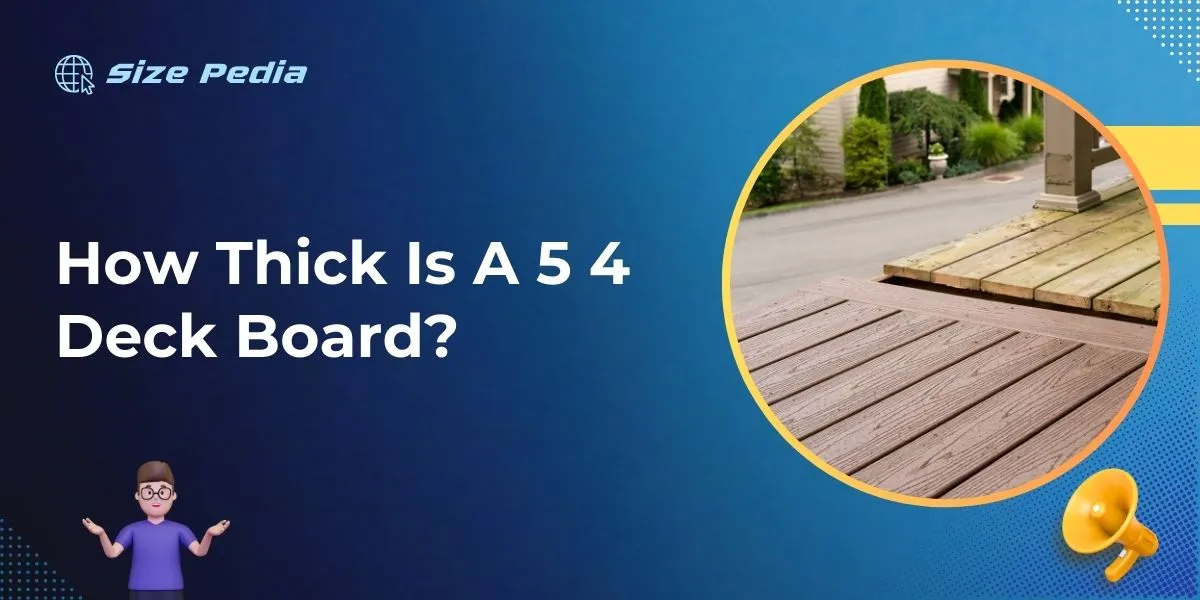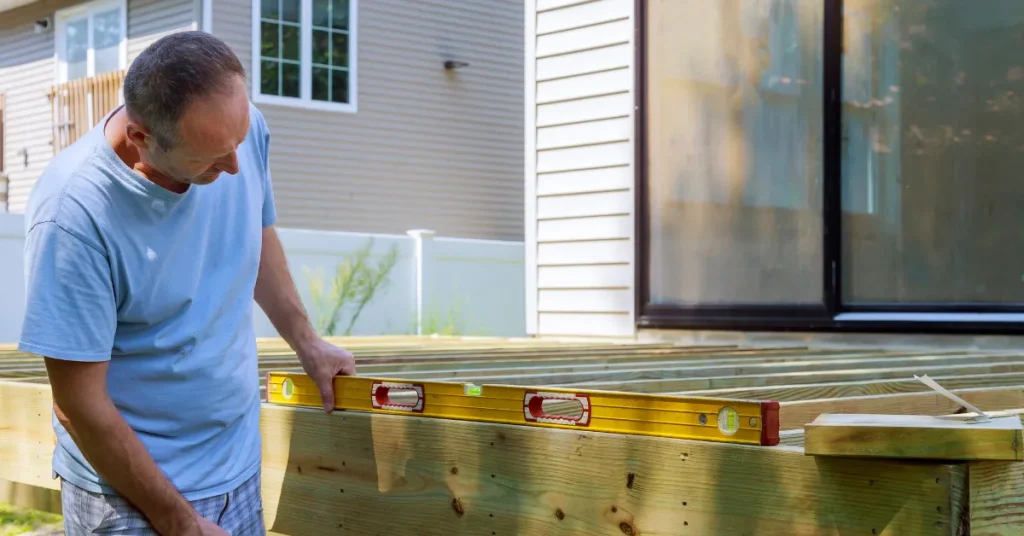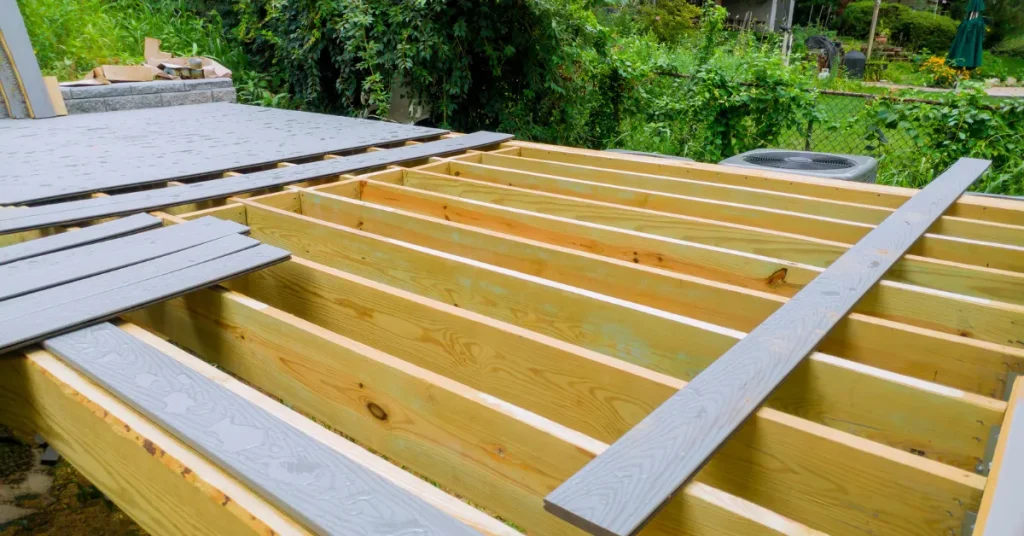A 5/4 deck board is typically 1 inch thick. It’s a common size for decking material.
When selecting decking materials, homeowners and contractors often choose 5/4 deck boards for their durability and aesthetic appeal.
These boards, measuring a true 1 inch in thickness, are thicker than standard 1x boards that actually measure only 3/4 inches. The term ‘5/4’ (pronounced “five-quarter”) refers to the rough-sawn size before the board is planed smooth.
This extra thickness ensures a sturdier decking surface, capable of handling heavy foot traffic and outdoor furniture.
Ideal for outdoor decks and patios, 5/4 deck boards provide a solid foundation for any backyard entertainment area or quiet retreat, adding value and beauty to your home’s exterior spaces.
With a variety of wood types and finishes available, these boards can be customized to match any design aesthetic, from traditional to contemporary.

Sizing Up 5 4 Deck Boards
Understanding the true thickness of a 5/4 deck board is crucial when planning your deck project.
People often mistake the label for exact dimensions. But there’s more to these boards than meets the eye. Let’s dive into what a 5/4 deck board actually brings to the table in terms of size.
Nominal Vs. Actual Measurements
A key thing to grasp about 5/4 deck boards is the distinction between nominal and actual sizes. Deck boards are sold using a nominal measurement, which is the size before the board is planed and finished.
The actual size is the board’s thickness after this process. So, a 5/4 deck board nominally means it’s one-quarter inch thicker than a 1-inch board. In reality, the true thickness may be different. It is usually 1 inch.
Common Dimensions Explored
Let’s look at the common dimensions you’ll encounter in the world of decking:
- Width: Typically, a 5/4 deck board will have a width of 6 inches.
- Thickness: Despite the “5/4” label, the actual thickness is closer to 1 inch.
- Length: Lengths can vary, but standard cuts are 8, 10, 12, 14, and 16 feet.
Deck builders and DIY enthusiasts must know these dimensions. It ensures that projects meet expectations in size, design, and structural integrity.
Always check with your lumber provider to verify the exact measurements before starting. This step helps avoid unwelcome surprises during the construction process.
| Nominal Size | Actual Thickness | Actual Width | Standard Lengths |
| 5/4 | 1 inch | 6 inches | 8, 10, 12, 14, 16 feet |
Remember, the actual measurements can slightly vary. It’s necessary to check them upon purchase. This preparation ensures a seamless install and a beautiful finish to your decking project.
Origins Of Lumber Measurements

Have you ever wondered why wood comes in such specific sizes? The way we measure and cut lumber today has deep roots in history.
Exploring these origins can provide a fascinating insight into the world of woodworking and construction.
Historical Context Of Lumber Sizing
Lumber measurements have an intriguing past. The story begins centuries ago. Wood was a primary building material. Size consistency was crucial for building reliable structures.
Craftsmen developed standard sizes to ensure uniformity. They measured in feet and inches. Over time, these standards evolved. They became vital to trade and construction across the world.
The ‘quarter system’ was a popular method. Lumber was measured in quarters of an inch. For instance, a 5/4 board was five quarters, or 1 ¼ inches thick.
The actual width was often less after the drying and planing process. This method provided a rough guide for carpenters and traders.
Modern Lumber Industry Practices
The lumber industry has grown. Technology improved. So did the precision of lumber sizing. Still, traditions play a role.
Lumber sizes now reflect the rough-cut size, not the final dimension. This is crucial for DIY enthusiasts and professionals to remember.
Safety and quality standards are higher today. Organizations oversee these measures. They ensure that the wood you purchase meets strict size and quality guidelines.
The nominal size is the name given to the lumber’s pre-surfaced measurement. The actual size is what you get after the wood is planed and dried.
| Nominal Size | Actual Size |
| 5/4 Deck Board | Approx. 1 inch thick |
Remember, a 5/4 deck board starts thicker. It’s then planed down to around 1 inch. This ensures a smooth, even surface for your decking.
Interpreting The Numbers
Deck boards come in various sizes. Numbers like 5/4 are common. But what do they mean? Understanding these measurements ensures the right purchase for your decking project.
The term “5/4”, in lumber speak, refers to the thickness of the board. Unlike dimensions like ‘two-by-four’, which are in inches, 5/4 represents a different scale.
- Fractional Measurements: Thuogh called “five-quarter,” it’s not actually 1.25 inches.
- Actual Thickness: It’s about 1 inch after milling and smoothing.
- Final Product: Typically used for deck surfaces, these boards provide sturdiness and aesthetics.
Lumber labels can be confusing. Grasping their meaning is key for the right materials. Here’s a quick guide:
- Nominal Size: This is the name of the lumber, such as 5/4.
- Actual Size: It’s the true measurement post-production.
- Labeled Size: Always check the labeled size against your project needs.
Tip: Always measure the board’s thickness with a ruler or caliper to ensure accuracy. Labels can sometimes lead to surprises.
| Nominal Size | Actual Size (inches) | Typical Use |
| 5/4 | 1 | Decking |
| 2×4 | 1.5 x 3.5 | Framing |
| 4×4 | 3.5 x 3.5 | Posts |
In summary, a 5/4 deck board typically has a thickness of about 1 inch. Always double-check measurements to match project requirements.
Measurement Variations
Measurement Variations in deck board thickness can affect the stability and appearance of your deck. Understanding these variations helps ensure the right choice for a lasting outdoor space.
Let’s explore how these measurements can differ due to regional standards and moisture levels.
Regional Differences In Thickness
Different regions have unique building codes and lumber milling standards. This results in slight variations in deck board thickness.
For example, a 5/4 deck board typically measures 1 inch thick. Yet, in some areas, it might be slightly thicker or thinner due to local preferences or material availability.
Here’s a quick overview of how deck board thickness may vary:
- Northeast: May see slightly thicker boards due to historical building practices.
- South: Preference often leads to a true 1-inch thickness for a sturdier feel.
- West Coast: Thinner boards might be more common, taking advantage of the wood’s natural strength.
Impact Of Moisture Content On Size
Moisture content plays a critical role in the size of a deck board. Wood expands as it absorbs moisture and contracts when it dries out.
A 5/4 deck board sold in a drier state may expand in a more humid environment, altering the actual thickness you may observe.
Consider these moisture-related size impacts:
| Condition | Expected Change in Size |
| High Moisture | Expansion in thickness and width |
| Low Moisture | Reduction, potentially causing gaps |
Always allow for potential expansion or contraction in your deck designs. Knowing how your deck boards react to the local climate can prevent unwanted future movement.
Application And Importance
The application and importance of choosing the correct thickness for a deck board cannot be overstated. It informs not just aesthetics but also the structural integrity and lifespan of a deck.
A common option is a 5/4 deck board, which refers to a board that is 1 inch thick and 5.5 inches wide. Let’s explore the nuances of selecting the right board thickness and its impact on durability and strength.
Choosing The Right Thickness For Your Project
Deck boards come in various sizes and selecting the appropriate thickness is crucial for the project’s success. A 5/4 deck board is popular for its balance between sturdiness and ease of installation. Here’s what to consider:
- Deck Use: High-traffic areas require thicker boards.
- Joist Spacing: Wider spacing may need thicker boards to prevent sagging.
- Aesthetics: Thicker boards offer a more robust look.
Strength And Durability Considerations
When it comes to deck construction, the strength and longevity of the deck boards ensure the safety and value of your investment. Here’s why a 5/4 deck board thickness makes a difference:
| Board Thickness | Bearing Capacity | Resilience to Elements |
| 5/4 Deck Board | Excellent support and reduced bounce | Better resistance to warping and splitting |
These boards stand the test of time, combating environmental stresses like moisture and temperature fluctuations. Proper maintenance further extends their lifespan.
Tips For Buying 5 4 Deck Boards

Buying 5/4 deck boards can be the start of your dream outdoor space. But, before you embark on this exciting project, there are vital tips that ensure you get the best materials.
Whether it’s for a cozy backyard deck or a grand porch, understanding the essentials in choosing the right deck boards is key. Let’s dive into how you can pick top-quality 5/4 lumber with confidence.
Quality Assessment Before Purchase
The life of your deck majorly depends on the quality of the wood. To get started, inspect each board. Look for straightness and avoid warping or curves. Check for uniform thickness and width for a seamless fit. Here’s what to keep an eye out for:
- Knots: Small, tight knots are okay, large or loose ones are not.
- Cracks: Also called checks, these should be minor, if present.
- Splits: They weaken the board, choose boards without splits.
- Moisture content: Should be low to reduce shrinking and warping.
Carry out a “knock test” by tapping two boards together. A clear, crisp sound indicates good density and dryness.
Navigating Home Improvement Stores And Lumberyards
Once you know what to look for, it’s time to head out to the store. But with the array of options, this can be overwhelming. To make your trip efficient, follow these steps:
- List down your requirements: Size, quantity, and type of wood.
- Ask for help: Store assistants can direct you to the right aisle.
- Use online resources: Many stores have online inventories. Check them before visiting.
- Inspect the stock: Use the tips from the “Quality Assessment Before Purchase” section.
Remember to check for certifications that indicate sustainable forestry practices.
FAQs About How Thick Is A 5 4 Deck Board
How Thick Should Boards Be For A Deck?
Deck boards should generally be at least 2 inches thick for structural integrity. Choose thicker boards for higher durability or heavier loads.
Is 1×6 Ok For Deck Boards?
Yes, 1×6 boards are suitable for deck boards, providing a balance between structural integrity and aesthetic appeal. Ensure proper spacing for ventilation and drainage.
How Far Apart Should 5 4 Deck Boards Be?
Deck boards should have a gap of 1/8 to 1/4 inch between them for proper drainage and expansion.
How Thick Is A 2×6 Deck Board?
A 2×6 deck board is typically 1. 5 inches thick and 5. 5 inches wide.
Conclusion
Understanding the thickness of a 5/4 deck board is crucial for your construction project. Generally, it measures approximately one inch.
This knowledge ensures your deck is stable, durable, and up to code. Remember, precise measurements lead to stellar results in the world of decking.
Choose wisely, build with confidence.
Resources:
1. https://basc.pnnl.gov/resource-guides/decks-are-wildfire-resistant
